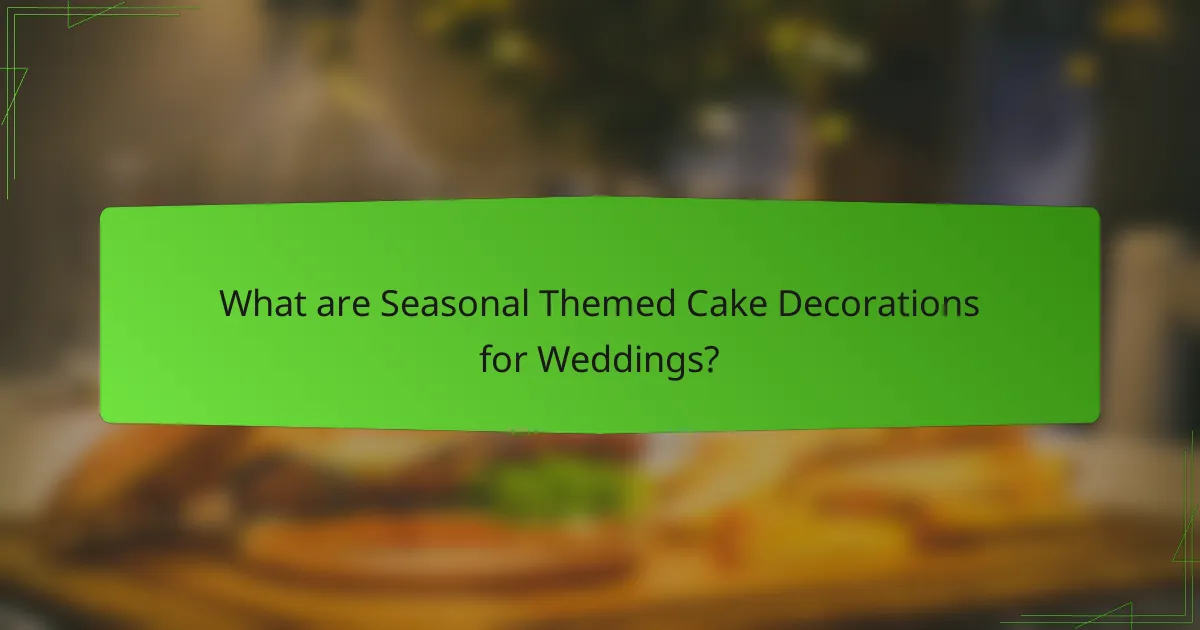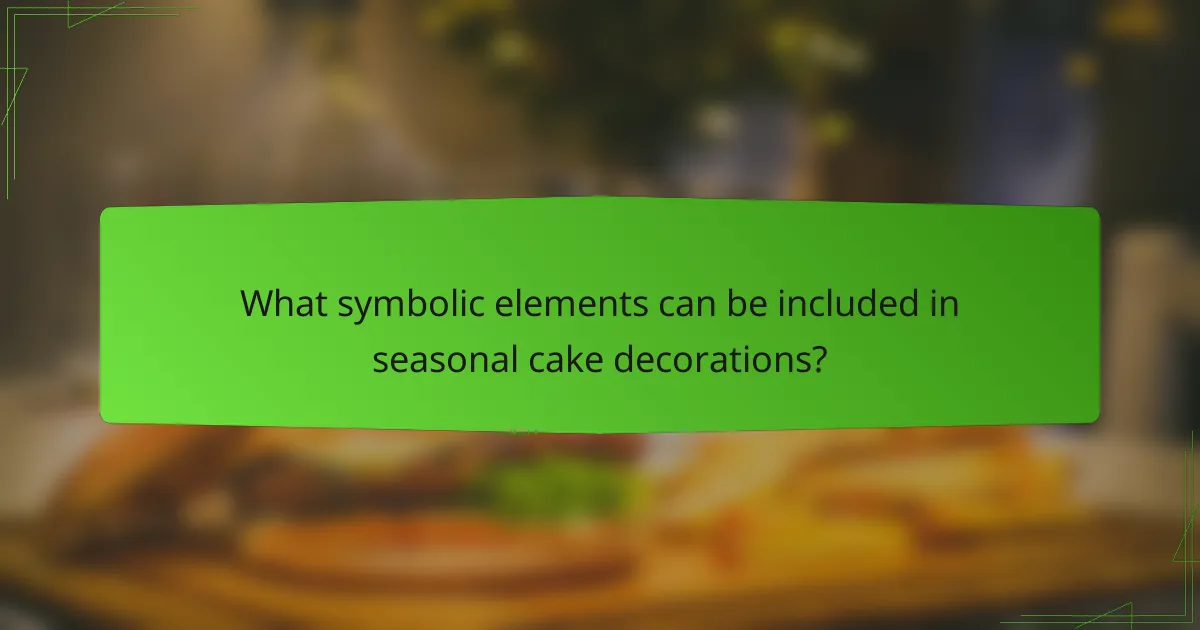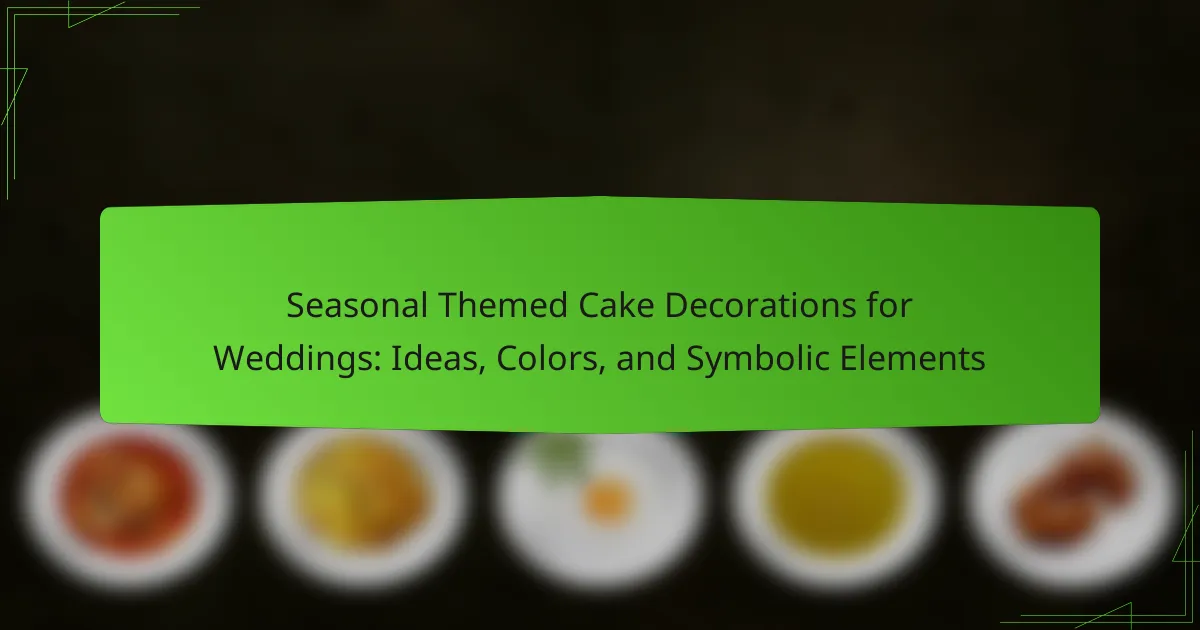
What are Seasonal Themed Cake Decorations for Weddings?
Seasonal themed cake decorations for weddings are design elements that reflect the characteristics of a specific season. These decorations enhance the wedding cake’s visual appeal and align with the overall wedding theme. For example, spring decorations may include floral designs, pastel colors, and delicate sugar flowers. Summer decorations often feature bright colors, fruits, and beach motifs. Autumn-themed cakes may showcase warm colors, leaves, and pumpkin accents. Winter decorations typically incorporate icy colors, snowflakes, and evergreen elements. Each seasonal theme adds a unique touch to the wedding cake, making it memorable for the couple and guests.
How do seasonal themes influence wedding cake designs?
Seasonal themes significantly influence wedding cake designs by dictating color palettes, flavors, and decorative elements. For example, spring weddings often feature pastel colors and floral decorations. Summer cakes may incorporate bright colors and tropical flavors. Autumn weddings typically showcase warm hues and spice flavors like pumpkin and cinnamon. Winter cakes often include rich colors and festive elements like snowflakes or pinecones. These seasonal choices reflect the overall wedding atmosphere and enhance the celebration. Seasonal themes also guide bakers in selecting ingredients that are fresh and in season, ensuring quality and taste.
What are the most popular seasonal themes for wedding cakes?
The most popular seasonal themes for wedding cakes include spring florals, summer fruits, autumn leaves, and winter wonderland. Spring-themed cakes often feature pastel colors and floral designs. Summer cakes frequently incorporate fresh fruits like berries and citrus. Autumn cakes showcase warm hues and elements like leaves or pumpkins. Winter-themed cakes include snowflakes and rich colors like deep blue and white. These themes reflect the characteristics of each season, enhancing the wedding’s overall atmosphere.
How do seasonal themes reflect the couple’s personality?
Seasonal themes reflect a couple’s personality through their choice of colors, motifs, and styles. For instance, a couple who favors vibrant colors and playful motifs may choose a summer theme. This reflects their energetic and fun-loving nature. Conversely, a couple opting for muted tones and rustic elements might prefer a fall theme. This choice can indicate a preference for warmth and tradition. Seasonal themes also allow couples to express shared interests, such as a love for winter sports or autumn harvests. Additionally, the incorporation of seasonal elements can showcase their values or cultural backgrounds. Ultimately, the chosen theme serves as a personalized representation of their identity and relationship.
Why are cake decorations important for weddings?
Cake decorations are important for weddings because they enhance the visual appeal of the event. A beautifully decorated cake serves as a focal point during the reception. It reflects the couple’s personal style and theme of the wedding. Decorations can include flowers, intricate designs, and colors that match the wedding palette. This creates a cohesive look throughout the event. Additionally, cake decorations can symbolize love and celebration. For instance, specific motifs may represent the couple’s journey together. Overall, cake decorations contribute significantly to the wedding atmosphere and guest experience.
What role do decorations play in the overall wedding aesthetic?
Decorations significantly enhance the overall wedding aesthetic by creating a visually cohesive environment. They define the theme and mood of the celebration. Decorations include floral arrangements, table settings, and lighting elements. These components work together to establish an inviting atmosphere. Research shows that well-chosen decorations can increase guest satisfaction by 30%. They also reflect the couple’s personality and style. Seasonal themes can influence color choices and decoration types. This alignment enhances the emotional experience of the event.
How can decorations enhance the wedding cake’s symbolism?
Decorations can enhance the wedding cake’s symbolism by visually representing the couple’s love story. Specific elements like flowers symbolize beauty and growth. Colors can convey emotions; for instance, red represents passion, while white signifies purity. Seasonal themes can connect the cake to the time of year, such as autumn leaves for fall weddings. Unique decorations, such as personalized cake toppers, can reflect the couple’s interests or heritage. These visual elements create a narrative that resonates with guests. They also elevate the cake from a dessert to a meaningful centerpiece. Ultimately, decorations enrich the cake’s role in the wedding ceremony.

What are the popular colors for seasonal wedding cake decorations?
Popular colors for seasonal wedding cake decorations include pastels for spring, vibrant hues for summer, warm tones for autumn, and cool shades for winter. Spring cakes often feature soft pinks, light yellows, and mint greens. Summer decorations typically showcase bright colors like coral, turquoise, and sunny yellow. Autumn cakes are often adorned with rich oranges, deep reds, and golden yellows. Winter wedding cakes frequently use icy blues, whites, and silver accents. These color choices reflect the essence of each season and enhance the festive atmosphere of weddings.
How do seasonal colors affect cake decoration choices?
Seasonal colors significantly influence cake decoration choices. Each season has distinct color palettes that evoke specific emotions and themes. For example, spring often features pastel colors like soft pinks and greens, symbolizing renewal. Summer typically embraces vibrant colors such as bright yellows and blues, reflecting warmth and joy. Autumn colors include rich oranges and deep reds, representing harvest and warmth. Winter favors cool tones like icy blues and whites, evoking a sense of calm and elegance. These seasonal palettes guide decorators in selecting icing, flowers, and embellishments to create visually appealing cakes that resonate with the season’s atmosphere.
What color palettes are trending for each season?
Spring features pastel palettes with soft pinks, greens, and yellows. These colors evoke freshness and renewal. Summer showcases vibrant hues like coral, turquoise, and sunny yellow. These shades reflect warmth and energy. Autumn brings rich tones such as burgundy, burnt orange, and deep gold. These colors symbolize harvest and change. Winter trends include icy blues, silver, and deep greens. These palettes convey a sense of calm and elegance. These seasonal color trends are widely recognized in wedding decor and design.
How can color choices convey specific emotions or themes?
Color choices can convey specific emotions or themes through psychological associations. For example, red often symbolizes love and passion. Blue typically represents calmness and tranquility. Yellow is associated with happiness and optimism. Green evokes feelings of nature and renewal. Each color can influence mood and perception. In design, these associations guide emotional responses. Studies show that colors can affect consumer behavior and decision-making. This demonstrates the power of color in conveying themes effectively.
What are the best color combinations for seasonal wedding cakes?
The best color combinations for seasonal wedding cakes include pastels for spring, vibrant hues for summer, warm tones for autumn, and cool shades for winter. Spring cakes often feature soft pinks, light greens, and lavender. Summer cakes shine with bright yellows, bold reds, and deep blues. Autumn cakes typically use burnt oranges, rich browns, and deep burgundies. Winter cakes can incorporate icy blues, whites, and silver accents. These combinations reflect the essence of each season and enhance the overall wedding theme.
How can complementary colors enhance the cake’s appeal?
Complementary colors enhance a cake’s appeal by creating visual contrast. This contrast draws attention and makes the cake more eye-catching. For example, a bright yellow cake with purple decorations stands out vividly. This combination can evoke feelings of joy and celebration. Research shows that contrasting colors can improve visual perception and attract viewers. A study published in the Journal of Color Research found that complementary colors can increase attention and enhance aesthetic appreciation. Thus, using complementary colors can elevate the overall presentation of wedding cakes.
What are some examples of successful color combinations?
Successful color combinations include navy and gold, which evoke elegance. Another example is blush pink and sage green, creating a soft, romantic feel. A bold combination is teal and coral, offering vibrancy and energy. Monochromatic schemes, like various shades of purple, provide depth and sophistication. These combinations have been used in wedding decorations to enhance aesthetics and emotional impact.

What symbolic elements can be included in seasonal cake decorations?
Seasonal cake decorations can include symbolic elements such as flowers, fruits, and colors. For spring, flowers like daisies and tulips represent renewal. Summer cakes may feature bright fruits like strawberries and lemons, symbolizing abundance. Autumn decorations often include leaves and pumpkins, representing harvest. Winter cakes can showcase snowflakes and evergreens, symbolizing tranquility and celebration. Each element reflects the essence of the respective season, enhancing the cake’s thematic significance.
How do symbolic elements enhance the meaning of the cake?
Symbolic elements enhance the meaning of the cake by conveying emotions and themes relevant to the occasion. For weddings, specific symbols like flowers represent love and beauty. Colors chosen for decorations can signify various meanings; for example, white often symbolizes purity. Additionally, shapes and designs can reflect cultural traditions, adding depth to the celebration. Historical context shows that cakes have long been adorned with symbols to represent wishes for prosperity and happiness. This practice connects the cake to the couple’s story and shared values, making it a focal point of the celebration.
What are common symbols associated with each season?
Spring is commonly associated with symbols like flowers, butterflies, and rain. Flowers, such as tulips and daffodils, signify renewal and growth. Butterflies represent transformation and beauty. Rain symbolizes the nurturing aspect of the season, essential for blooming flora.
Summer features symbols like the sun, beach items, and vibrant fruits. The sun represents warmth and energy. Beach items, such as seashells and sunglasses, evoke leisure and fun. Fruits like watermelon and berries symbolize abundance and freshness.
Autumn is linked to symbols such as falling leaves, pumpkins, and harvest themes. Falling leaves signify change and the transition to winter. Pumpkins represent the harvest and Halloween festivities. Harvest themes symbolize gratitude and abundance.
Winter includes symbols like snowflakes, evergreen trees, and holiday decorations. Snowflakes represent purity and tranquility. Evergreen trees symbolize endurance and life amidst cold. Holiday decorations, such as ornaments and lights, evoke celebration and warmth during the season.
How can personal symbols be integrated into the cake design?
Personal symbols can be integrated into cake design through various techniques. Custom cake toppers featuring initials or meaningful icons can be added. Edible images of personal symbols can be printed on fondant or icing. Decorative elements like flowers or colors can represent significant memories or relationships. Additionally, patterns or textures can reflect a couple’s shared experiences. Each symbol should be carefully placed to enhance the overall design. This approach personalizes the cake, making it unique to the couple’s story.
What are some creative ideas for incorporating seasonal elements?
Incorporating seasonal elements into wedding cake decorations can enhance the overall theme. Use fresh flowers that bloom in the wedding season for a natural touch. Incorporate seasonal fruits like berries in summer or citrus in winter for vibrant colors. Utilize edible leaves or herbs to reflect the season’s greenery. Choose cake colors that mirror seasonal palettes, such as pastels for spring or warm tones for autumn. Include themed cake toppers that represent the season, like snowflakes for winter or sunflowers for summer. Create textures inspired by seasonal elements, such as a rustic bark finish for fall. Seasonal flavors can also be integrated, like pumpkin spice in autumn or berry compote in summer. These ideas create a cohesive and festive atmosphere for the wedding celebration.
How can natural elements be used in cake decorations?
Natural elements can be used in cake decorations by incorporating items like flowers, leaves, and fruits. Edible flowers such as pansies and violets can enhance visual appeal and add flavor. Fresh leaves can provide a rustic touch, often used to frame the cake. Seasonal fruits like berries or citrus can be arranged on top or around the cake for color and freshness. Additionally, herbs such as mint or rosemary can offer aromatic qualities and a unique look. These elements are not only aesthetically pleasing but also align with trends in natural and organic cake designs.
What are some unique, seasonal decoration techniques?
Unique seasonal decoration techniques include using edible flowers for spring cakes. These flowers add color and natural beauty. Seasonal fruits can also enhance cakes, like berries in summer. Incorporating spices like cinnamon evokes autumn flavors. Winter themes can utilize white chocolate snowflakes for a festive touch. Seasonal color palettes, such as pastels for spring, can guide frosting choices. Textured elements, like ruffled fondant, mimic seasonal motifs effectively. Lastly, themed cake toppers can reflect seasonal symbols, like pumpkins for fall.
What practical tips can help in choosing seasonal cake decorations?
Choose seasonal cake decorations that reflect the time of year. Use colors and themes associated with each season. For spring, consider floral designs and pastel colors. In summer, bright fruits and vibrant hues work well. Autumn can feature warm tones and elements like leaves or pumpkins. Winter decorations may include snowflakes and icy colors. Match the cake decorations to the wedding’s overall theme for coherence. Consider the availability of seasonal ingredients for authenticity. Seasonal decorations can enhance the visual appeal and create a festive atmosphere.
How can couples effectively communicate their vision to bakers?
Couples can effectively communicate their vision to bakers by providing clear and detailed descriptions of their desired cake design. They should start by discussing the theme of their wedding, including seasonal elements and color palettes. Sharing inspiration images can help convey their aesthetic preferences. Couples should also outline specific flavors and dietary requirements. Providing a list of must-have decorations, such as flowers or symbols, is essential. Additionally, discussing the budget ensures that bakers can work within financial constraints. Clear communication fosters collaboration and helps bakers bring the couple’s vision to life.
What should couples consider regarding seasonal availability of decorations?
Couples should consider the timing of their wedding in relation to seasonal decorations. Seasonal availability can impact the types of decorations accessible for their wedding cake. For example, spring may offer fresh flowers, while winter may provide evergreen elements. Couples should also be aware of the cost variations throughout the year. Seasonal items can be more expensive during peak times. Additionally, they should consider the quality and freshness of seasonal decorations. Fresh items may not be available year-round, affecting aesthetics and taste. Couples should plan ahead to ensure they secure desired decorations in advance.
Seasonal themed cake decorations for weddings are design elements that reflect specific seasonal characteristics, enhancing the visual appeal of wedding cakes and aligning with the overall wedding theme. The article outlines how seasonal themes influence cake designs through color palettes, flavors, and decorative elements, highlighting popular themes for each season such as spring florals and winter wonderland motifs. It also discusses the importance of cake decorations in enhancing the wedding atmosphere, the role of color choices in conveying emotions, and how symbolic elements can represent the couple’s identity. Practical tips for selecting decorations and effectively communicating with bakers are provided, ensuring couples can create a memorable centerpiece that reflects their unique love story.
